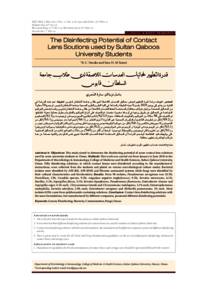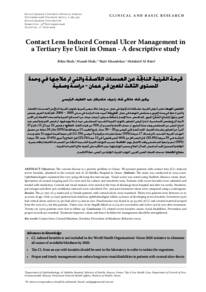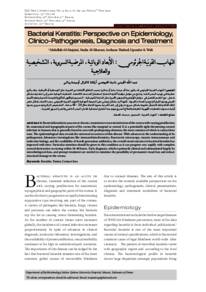Document
The Disinfecting potential of contact lens soutions used by Sultan Qaboos University students.
Contributors
Al-Sumriyah, Sara H., Author
Other titles
قدرة التطهير لمحاليل العدسات اللاصقة لدى طلاب جامعة السلطان قابوس
Publisher
College of Medicine, Sultan Qaboos University.
Gregorian
2011-05
Language
English
English abstract
aBstract: Objectives: This study aimed to determine the disinfecting potential of some contact lens solutions
used by some university students in Oman. Methods: This work was carried out from January to June 2010 in the
Department of Microbiology & Immunology, College of Medicine and Health Sciences, Sultan Qaboos University,
Oman. Fifty disinfecting solutions, in which contact lenses were disinfected according to the manufacturers'
instructions, were collected from the students and plated on various microbiological culture media. Bacterial
isolates were identified by API-20E, API-20NE and Phoenix automated systems while fungi were identified by
their cultural characteristics and biochemistry. Results: From 98 isolates, Pseudomonas aeruginosa was 23.5%;
Penicillium, 13%; Candida species, 9.2%; coagulase negative staphylococci, 9.2%; Serratia marcescens, 6.1%;
Bacillus, 5.1%; Aspergillus flavus, 5.1%; Serratia liquefaciens, Pseudomonas fluorescens, Enterobacter cloacae and
Aspergillus niger, 4.1% each; Chryseomonas luteola and Chryseomonas indologenes, 3.1% each; Stenotrophomonas
maltophilia, Serratia odorifera, 2.0% each; Enterobacter aerogenes and Klebsiella pneumoniae, 1% each. Most
isolates (65%) came from polyhexanide containing solutions. Conclusion: Contact lens disinfecting solutions with
the same formulations, but manufactured by different companies, possessed different disinfecting potentials.
Member of
Resource URL
Arabic abstract
الملخص: الهدف: دراسة قدرة التطهير لبعض محاليل العدسات اللاصقة لدى طلاب جامعة السلطان قابوس: الطريقة: تمت هذه الدراسة في الفترة ما من يناير إلى يونيو 2010 بقسم الأحياء الدقيقة والمناعة في كلية الطب والعلوم الصحية بجامعة السلطان قابوس. تم جمع 50 محلولاً من المحاليل المصنع من قبل شركات مختلفة والمستخدمة لحفظ العدسات اللاصقة من طلاب جامعة السلطان قابوس. وقمنا بفحص الجراثيم المتواجدة في المحاليل عن طريق زرعها في أوساط مخبرية متعددة. تم التعرف على أنواع الجراثيم والفطريات بطرق معملية معينة. النتائج: تم التعرف على 98 سلالة من الجراثيم والفطريات المختلفة, منها (23.5%) كانت لبكتيريا السيودوموناس اريجينوسا، و(13%) للبنسليوم, و (9.2%) لكل من فطريات الكانديدا والمكورات السبحية غير الفارزة لإنزيم التخثر, و (6.1%) لسيراتيا مار سيسينس، و (5.1%) لكل من العصيات والاسبيرلس فلافس، و (4.1%) لكل من سيراتيا ليكوياسينس وسيودومونا فلوريسينس وانتراكنز كلويكيا واسبرجلس نيجر، و(3.1%) لكل من كريسوموناس ليوتولا وكريسوموناس اندولوجينس، و (2%) لكل من ستينوتروفومانس مالتوفيليا وسيراتيا اودوريفيرا و (1%) لكل من انتيروباكتر اريجونيس وكليبسيللا نيومونيا. لوحظ أن أكثر من (65%) من سلالات الجراثيم كانت من المحاليل المحتوية على بوليهكساتيد. الخلاصة: أوضحت الدراسة أن المحاليل المستخدمة لحفظ العدسات اللاصقة تحوي نفس المكونات ولكنها منعة من عدّة شركات لها قدرات تطهير مختلفة.
Category
Journal articles




